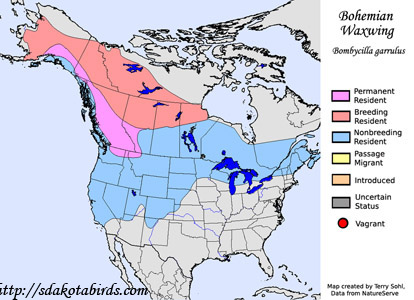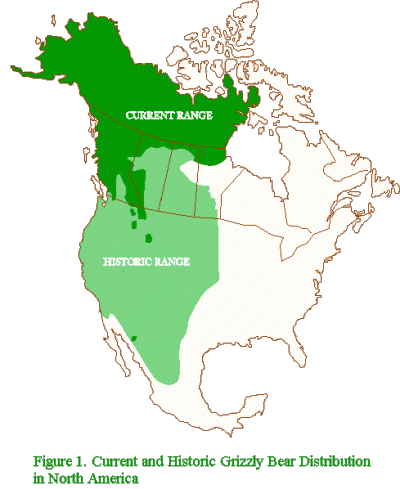Bohemian Waxwing a.k.a. "Grizzly Bear Bird".
Credit: Jeff Wells
Birders in many parts of southern Canada and the northern U.S. were fortunate this past winter to have been blessed with large numbers one of my favorite Boreal birds, a species I like to call the Grizzly Bear Bird. I don’t call them that because of their demeanor--they are generally among the more demure of bids—or because of their diet as they generally focus on berries rather than meat. Grizzly Bear Birds are also not massively large and do not have larger than normal claws.
The reason that I like to call Bohemian Waxwings by the nickname, Grizzly Bear Bird, instead of their real name when I am showing them to people who have never seen them is because the known North American breeding range of the Bohemian Waxwing overlaps almost completely with the current distribution of the Grizzly Bear. Both are now found largely in the western Boreal from Alaska to northern Manitoba, though Grizzly Bears once roamed over at least half of the U.S. and Bohemian Waxwings have been found nesting as far east as northwestern Ontario and are suspected to now nest in northern Quebec.

Range map of the Bohemian Waxwing.
Borrowed from the South Dakota Birds and Birding website

Range map of the Grizzly Bear.
Borrowed from the B.C. Ministry of Environment website
When I see a large flock of Bohemian Waxwings in Maine, I find it fascinating to think that the birds I am looking at have come from the same place where Grizzly Bears roam, and that these same birds have (unlike me) actually seen a Grizzly Bear in the wild. From the time I started learning about the natural world and about birds, in particular as a child, I have always been entranced by these kinds of connections whether it is the story of the Grizzly Bear Bird or the Amazon Warbler (that’s what I sometimes call the Boreal-breeding Blackpoll Warbler because of where it spends the winter). I still remember how excited I was when I saw my first Glaucous and Iceland Gulls in the winter in Maine and realized that these birds had come from the Arctic and probably had seen Polar Bears. I find that these kinds of stories and connections resonate with many non-birders I meet, whether kids or adults, and help to open up the mystery and wonder of nature. Or course they will never find my made-up nicknames in a bird book, but hopefully they will at least remember something about the bird’s life history.

Bohemian Waxwings are often highly mobile.
Credit: Jeff Wells
Bohemian Waxwings, like the more widespread Cedar Waxwing, are great wanderers, with flocks sometimes moving over thousands of miles in search of food. Banded birds have rarely (never??) been found in the same areas from one year to the next. The Birds of North America account by my fellow Cornellian Mark Witmer notes that an individual Bohemian Waxwing banded in British Columbia in February 1993 was recovered 13 months later in South Dakota. Another banded in Saskatchewan in February 1968 was recovered five years later in British Columbia. And one banded in Saskatchewan in April 1962 was recovered a year later in North Dakota.
Bohemian Waxwing feeding on crabapple:
There were still significant numbers of Grizzly Bear Birds lingering here in Maine into early April as they looked for the last of the crabapples and berries to scarf up before heading back north and west, presumably to places like British Columbia, Northwest Territories, Yukon, and Alaska. Here are some photos and video that I took of some close flocks I found in Bangor, Maine in late March and Randolph, Maine in early April (Credit: Jeff Wells):






